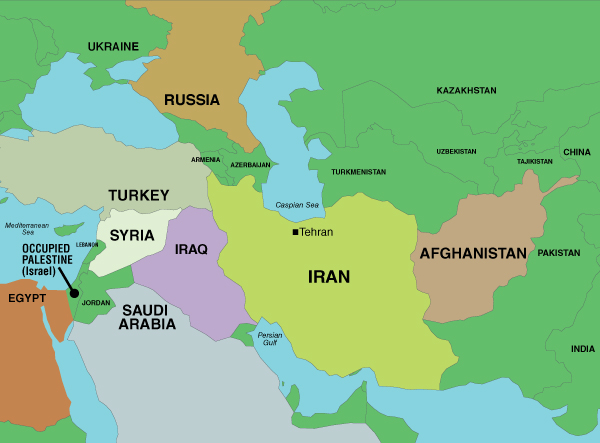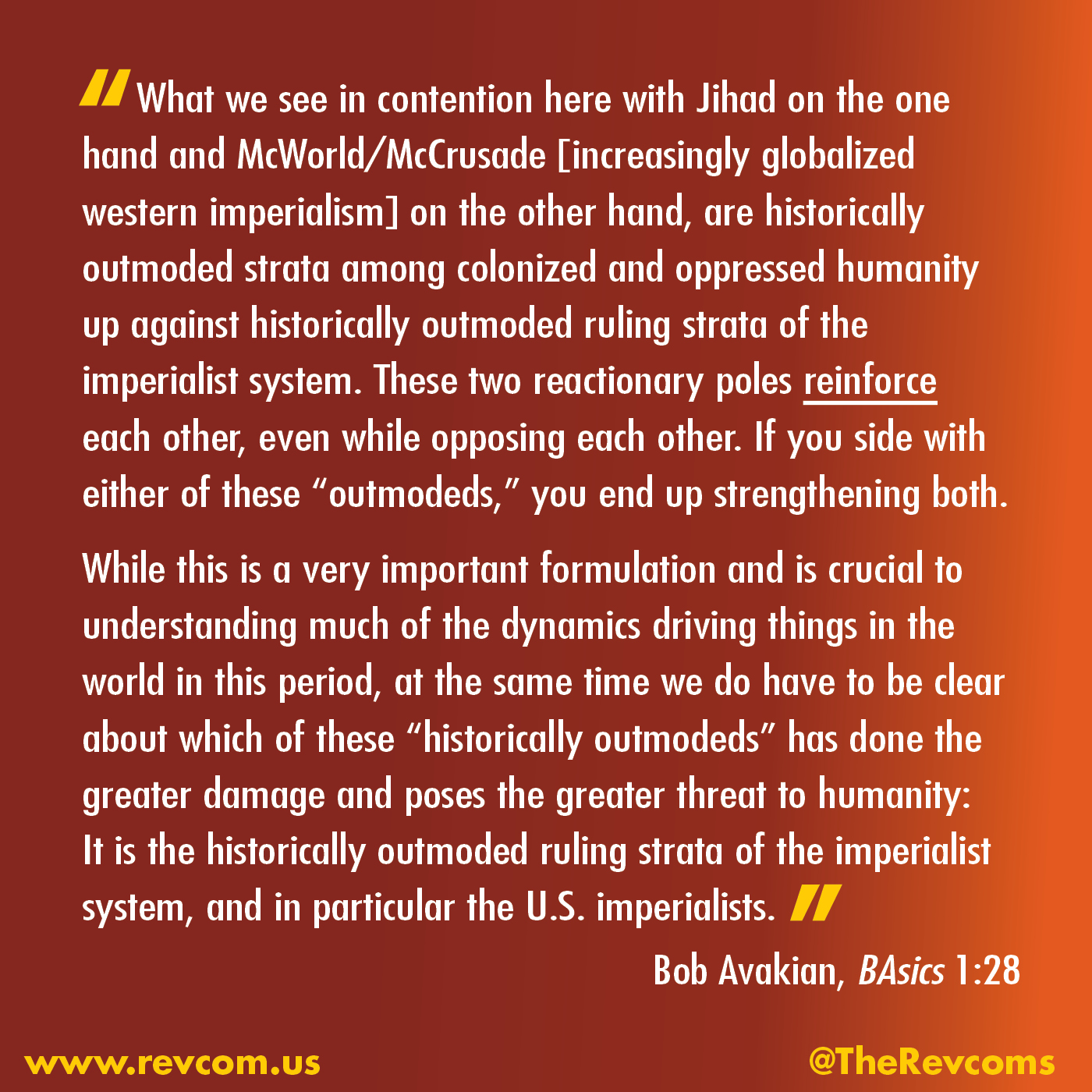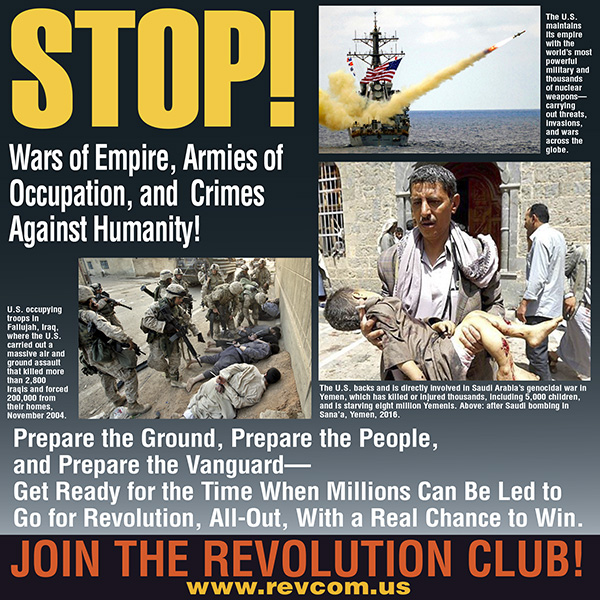Gangsters Debate Which Crimes Best Serve Their “National Interests”
What Is Revealed and What Is Missing in the New York Times’ “Secret History of the Push to Strike Iran”?
| revcom.us
On September 4, the New York Times Magazine published “The Secret History of the Push to Strike Iran,” based on extensive interviews with present and former government officials over the last two decades. It fleshes out a complex, 17-year-long struggle within and between the U.S. and Israeli ruling classes1 about how to deal with Iran2—through what combination of crushing economic sanctions, internal subversion, military threats, bombing or outright invasions could Iran be made to bend to U.S. demands and fit itself into U.S. domination of the region.
Largely this struggle has focused on how to prevent Iran from producing nuclear weapons, thus maintaining the U.S./Israeli monopoly on nuclear weapons that is a key element of their control of the region. Israel has 80-90 nuclear warheads, and the U.S. has over 6,000; both have the ability to launch warheads from air-, sea- and land-based delivery systems. Iran has no nuclear missiles or warheads, making it 100% vulnerable to U.S. and/or Israeli nuclear blackmail.
There is much in the Times article—some of it previously known, some new information—that should be shocking:
- In 2007, when George W. Bush was president, Israeli defense minister Ehud Barak ordered his “general staff to develop plans for a large-scale attack on Iran.”
- In 2009, Obama promised the pro-Israel lobby AIPAC that he would “always keep the threat of military action on the table to defend our security and our ally Israel.” In 2012, “the Obama administration… develop[ed] its own military contingency plans” for war with Iran, “including destroying a full-size mock-up of an Iranian nuclear facility in the western desert of the United States with a 30,000-pound bomb.”
- In 2010, the Obama administration conveyed a message to the Iranian rulers to the effect that “there was a chance for a peaceful denouement to the nuclear standoff with Iran but [the U.S.] was prepared to take military action if Iran rejected diplomacy.” [Emphasis added] This gangster threat (coupled with devastating economic sanctions) was the impetus for the 2015 JCPOA [the nuclear deal between Iran, the Obama administration and other imperialist powers that Trump later pulled out of].
- In 2012, Israel was so close to launching a military attack on Iran that Israel’s U.S. ambassador said that every night he slept “with the phone close to my ear… ready to be called in by Israel and sent to the White House or the State Department to tell them we had attacked”
- Ultimately the Obama administration decided that it wouldn’t help Israel in an initial attack on Iran, “but it wouldn’t stand in Israel’s way.” And in July 2012 Obama ordered “a buildup of America’s arsenal around the Persian Gulf,” so as to be able to back Israel up once things got going. “Gen. James Mattis, the head of United States Central Command, urged the C.I.A. to try to locate Iranian missile launchers—they would be among the first targets of an American campaign if an Israeli strike drew the United States into the conflict.”
- Trump’s recently fired National Security Advisor, John Bolton, wrote an op-ed in the Times in 2015 titled “To Stop Iran’s Bomb, Bomb Iran.” In 2017, not long before being hired onto the Trump regime, he had publicly promised anti-regime Iranians that “that in two years, Iran’s leaders would be gone and that ‘we here will celebrate in Tehran.’”
In other words, what we see, running through three different U.S. administrations, is example after example of imperialist gangsters and their Israeli allies discussing and debating unprovoked acts of war, subversion, and economic terrorism against another country, all with the aim of establishing complete domination of the region by the U.S. and its close allies. So here you have the U.S. dictating to the countries of a region halfway around the world as to what the power alignments would be, who could have what weapons, and so on. This is scarcely different than the infamous Berlin Conference in the 19th century when the big powers in Europe drew lines through a map of Africa and divvied up who would get what.
Yes, there were differences among different U.S. leaders, but not over fundamentals. Obama wanted to rely mainly on sanctions and was willing to allow Iran to remain a significant force “shar[ing] the neighborhood” with close U.S. ally Saudi Arabia, whereas forces around Trump aim for “a realignment of the Middle East, with Israel and select Sunni nations gaining supremacy over Iran and containing the world’s largest Shiite-majority state [Iran].” [Emphasis added.] But both insisted on subordinating Iran to U.S. interests, and both were ready to impose suffering and starvation, bombs and invasions on the people of Iran, even to risk “unspool[ing] widespread chaos” in the whole region, including wider wars and economic collapse if it served “U.S. interests.”
What Is Missing?
What is missing from this 10,000-plus word article is anything that any of the big power protagonists say, or that the Times reporters say, that reflects the slightest concern for the lives and well-being of the 80 million people of Iran, or for the interests of humanity as a whole. These things just do not exist in their worldview.
Not once does the Times report that anyone in any of the many debates they report on or the interviews they conducted says, “We cannot wage war on another country just because they don’t do what we want” or “We cannot plot to overturn the government of another country” or “We really have to be aware that these economic sanctions don’t just ‘squeeze’ some abstract ‘Iranian economy’—they cause massive suffering for tens of millions of people and bring death to the most vulnerable—to infants, to the ill and to the elderly.”
Nowhere does anyone even make the point that “obviously, everything we are discussing here is completely illegal under international law and we will have to start working on our lies and pretexts right now to cover up what we are really doing.” Everyone is completely locked into a framework that the only thing that matters is the interests of the U.S.—which are in fact the interests of U.S. imperialism.
The fact that all this went on is a stunning indictment of the criminality of the imperialist system. The fact that the NY Times article approaches this all as legitimate discussion, rather than as scandalous and outrageous, and that these revelations provoke zero outrage in society at large is frankly an indictment of how corrupted by imperialist national chauvinism the U.S. population—including the liberal and progressive readership of the Times—has become.
And all of it together should be a challenge to all those who do see this for the monstrous criminality that it is—to step up to the challenge of the 5-2-6, and make a choice to bring about a radically different world.
1. Israel is fundamentally and overwhelmingly dependent on the U.S.—for money, high-tech weapons and political cover. Moreover, the U.S. is Israel’s ultimate “protector”—any force that threatens Israel knows it may face the full military power of the U.S. On the other hand, the U.S. needs Israel—a relatively stable, highly militarized and solidly pro-U.S. state right at the heart of one of the most economically and strategically important regions of the world. In this context, in spite of the lopsided power relationship, Israel is often able to push for its own specific interests and views, often leveraging splits in the U.S. ruling class to its advantage. Generally, the hard line “hawks” in Israel—grouped around Prime Minister Benjamin Netanyahu—work closely with the Christian fascists and the Trump regime in the U.S. For more see Revolution special issue on Israel. [back]
2. The Islamic Republic of Iran, a predominantly Shi’ite country of 80 million people, is a major regional power in the Middle East. Its rulers are vicious oppressors in their own right and overall eager to facilitate the imperialist plunder of Iran’s resources and people as long as they get their cut. But they often oppose U.S. and Israeli interests in the region, directly or through forces in other countries they are aligned with. And Iran represents a pole of opposition that strengthens other regional forces that the U.S. and Israel want to subordinate. [back]

Map of the Middle East and surrounding regions
Clip: "Free Yourself from the GTF!"

Bringing Forward Another Way is an edited version of a talk by Bob Avakian, Chairman of the Revolutionary Communist Party, USA, to a group of Party supporters in 2006. It is must reading for a serious understanding of what the U.S. "war on terror" is really about and how to bring forward a positive force in the world in opposition to both Western imperialism and Islamic Jihad.
Get a free email subscription to revcom.us:



